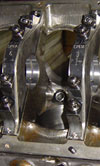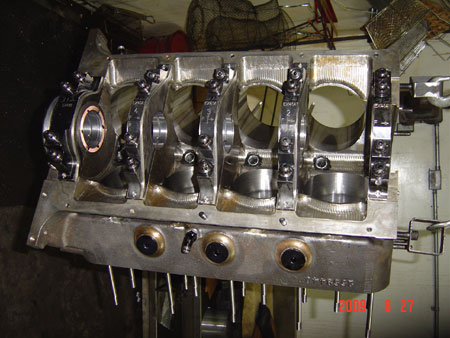RF85
 RF85 was covered last year in the pages of the May 2009 Race Engine Technology, but in that instance most of the data presented referred to the results of tests on cutting tools such as saw blades and taps.
RF85 was covered last year in the pages of the May 2009 Race Engine Technology, but in that instance most of the data presented referred to the results of tests on cutting tools such as saw blades and taps.
I spoke recently to the owner of Better Than New, in Tennessee, US, the company which carries out the RF85 surface treatment and which claims to reduce dry friction between metal pairs by around 85% (hence the name RF85).
RF85 say people send the whole disassembled engine for treatment, which is a low-temperature immersion process developed in 1999, and parts to be treated are immersed for an hour. While temperature is involved, the processing temperature is said to be lower than the ageing temperature of any of the metals processed.
The result of the process is the diffusion of elements such as calcium and sulphur into the surface of the material, and there is evidence that while the gains aren't so large with all materials, there are significant reductions in friction for most metals including aluminium and titanium. The process is even applied to coated parts with claims of good results, even when applied to DLC-coated components.
In common with some of the coating processes applied to reduce friction and increase wear resistance, the results with this treatment are claimed to be better when both surfaces in sliding contact are coated, with friction reduction of up to 95% in some circumstances.
In addition to a reduction in friction, there are real gains to be had in the longevity of parts - and, if the impressive results found in initial testing in transmission components and engines in the US can be replicated in engines where there is a minimum lifetime requirement (Formula One and MotoGP being obvious examples) then there could be real cost savings.
In transmission applications, this treatment has allowed racers to run with a substantially less oil, and the reduced shear losses mean temperatures are lower so there is a lower cooling requirement on the car.

One area of particular success is in treating interference-fit nested valve springs. Quite often these need to be changed due to wear in the area of contact between the two (or three) springs. Bearing shells are also reported to be a successful application of this coating, with less wear reported on strip-down.
One notable result reported is that engines treated by this process show less degradation of performance over their lifetime than untreated engines.
The treatment is widely applied in racing in the US, with customers in Late Model racing, ARCA and NASCAR all bringing repeat business for this process. Racing is said to be a 'distant third place' though in terms of sales revenues for this process, with other significant applications being cutting tools and firearms.
One 'problem' with the coating is that it can't be detected by eye, so there is no visual difference between coated and uncoated parts. The accompanying picture shows a treated cylinder block assembly.
Fig. 1 - This cylinder block assembly has been treated using the RF85 process (Courtesy of Better Than New)
Written by Wayne Ward